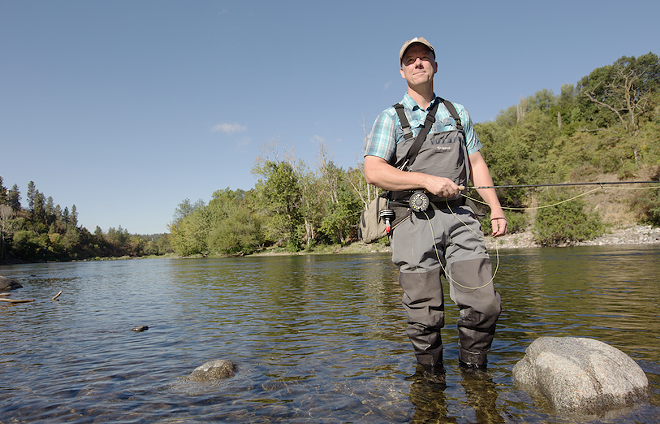Saturday, October 4, 2014
OUTLANDER serves as a weekly round up of Inland Northwest outdoor recreation and natural resources news. This feature will highlight a wide variety of issues and events, ranging from camping stories to national environmental disputes. We’ll also try to include some scenic photos. Feel free to pass along suggestions or curiosities. The Inlander looks forward to sharing and celebrating the Great Outdoors.
—
So we have a huge story on the water quality history of the Spokane River this week, including some info on the new Riverkeeper, city water plans, fish consumption, lots of sewage, drunken inner tubing and the great Expo '74 fish massacre. We're hoping this story can serve as a foundation for future coverage, so feel free to pass along updates on other issues tied into the health of the river. (Inlander)
Speaking of which, the state Dept. of Ecology put out draft fish consumption rules this week. Lots of folks are less than impressed. (Inlander)
As the weather turns a bit brisker, Washington State Parks have posted their off-season parks schedule. (WAParks)
The Washington State Parks Foundation is also accepting applications for small grants on park improvement projects. (WSPF)
Widely respected climber and guide Liz Daley, of Tacoma, died Monday in an avalanche in Argentina. (Bellingham Herald)
The Huckleberry wolf pack conflict reportedly cost $53,000. (S-R) WDFW officials will host a meeting on wolf management in Colville on Oct. 7. (WDFW)
State officials have lifted burn bans on many areas of Eastern Washington. (WDFW)
The Washington Trails Association will close its annual Northwest Exposure outdoor photography contest on Oct. 19. Prizes awarded in categories like Trailscapes, Camp Life and Hikers in Action. (WTA)
Speaking of outdoor photos, the Forest Service took a lot of heat last week over improperly forcing photojournalists to get expensive permits in wilderness areas. (Seattle Times)
Meanwhile, the U.S. Forest Service releases a video feature on what it takes to be a wildland firefighter. (USDA)
A not-so-surprising study concludes hiking makes you happier. (Outside)
Anyone who missed the Pacific Northwest Climate Science Conference in September can watch the speakers online. (PNCSC/Youtube)
A WWF International study finds total wildlife populations have decreased by 52 percent over the past 40 years. (AP)
Friday, October 3, 2014
Call it an amicable divorce.
Last week, the Inlander published a story about the conflict between Washington State University and the University of Washington. It detailed how WSU’s concerns about the lack of medical students in rural areas of Washington and its conflicts with UW had led it to pursue the creation of its own medical school. Yet UW was worried that school would suck away resources from its own program in Spokane and harm a 43-year-partnership.
Yet the moment the story went online last Wednesday, hours of discussions were underway in UW president Michael Young’s office. The discussions, between Young, WSU president Elson Floyd, UW regent Orin Smith, WSU regent Mike Worthy, Avista CEO Scott Morris and former Providence CEO Mike Wilson, lasted hours.
“Both organizations felt this was something for us to sort out as opposed to asking our state legislature to sort it out,” Worthy says.
When they were finished, it ended with a handshake. An agreement had been reached. A nasty legislative battle between the two universities had been avoided.
Ultimately, it means WSU can freely pursue their medical school, but will be dissolving their "WWAMI" partnership with UW. Both schools will seek to expand medical education in Spokane, and neither will oppose the other's goals in the legislature. The details about reallocation of state resources and use of the Spokane facility still have to be worked out, but all that negotiation will take place before the legislature kicks off in January.
Today, the UW website, once devoted to rebutting WSU's claims about their own medical school, announces:
Leadership at the University of Washington and Washington State University have reached an agreement that will mutually dissolve their WWAMI partnership and provide a pathway to pursue separate solutions to address the state’s medical education needs and physician shortage.
In order to provide the greatest benefit to the state and to meet the significant demand for more physicians, leaders from both universities agree that UW and WSU will independently pursue their respective proposals to meet the state’s medical education needs. The two universities have signed a Memorandum of Understanding that acknowledges both WSU’s immediate efforts to secure accreditation for a new medical school and UW School of Medicine’s independent pursuit of rapid expansion of its four-year WWAMI program in Spokane.
“The collective needs of our students, the Spokane community, and our state are our top priority,” said UW President Michael K. Young. “To this end, the UW remains fully committed to immediately expanding our medical school in Spokane, including a commitment to grow the research, industry commercialization and medical residency opportunities that will ensure a vibrant, healthcare economy well into the future.”
"Let me just say this: The outcomes of our discussions will lead to more doctors in Eastern Washington than any of us had previously discussed,” Worthy says. “It’s going to be great for Spokane... I think both universities have really put themselves out there, to get the job done to address the challenge of the shortage of docs.”
People with severe mental health issues have increasingly ended up in the Spokane County Jail where they may spend months awaiting competency evaluations and often decompensating under solitary confinement and limited treatment, reports the jail’s mental health manager in a court declaration filed today.
Kristina Ray, who has overseen the jail’s mental health treatment since 2008, writes she has seen more inmates, often on minor charges, flooding the county jail. Many also show signs of more severe mental health issues as lockdown security protocols only intensify their symptoms.
Spokane County Jail is the only county jail in the state to be licensed as a mental health provider. Despite that certification, Ray says the facility can only do so much as a jail. Most inmates with serious mental health issues spend 23 hours a day in a cell on the mental health floor, which at a capacity of 46 cells is always full. All female inmates stay in separate solitary cells two floors down.
“We have no other place for them,” Ray writes in her declaration. “Unfortunately, solitary confinement is not therapeutic and exacerbates their symptoms. So, the proactive treatments we can provide are not as effective because inmates with mental health illness are both being held in isolation and in a correctional setting.”
Ray explains the number of jail inmates waiting for mental health evaluations has also increased significantly in the past four years. Before they ever see a trial, they spend weeks or months in solitary confinement for an evaluation to determine what kind of treatment they may need.
“I have seen dozens of inmates decompensate after the jail restricts both their freedom of movement and social interaction,” she writes. “Their mental health is further undermined by being housed near other inmates with mental illness who are often kicking and screaming in their cells.”
Ray raises one example of a female inmate who was booked into the jail in April on two misdemeanor assault charges. She has spent six months waiting in one of the jail’s suicide watch safety cells for an evaluation.
“A safety cell, the type of cells used on suicide watch, only has a toilet and sink,” Ray writes. “Inmates will then be evaluated to determine if they can have undergarments, socks, bedroll, pencils, or personal belongings in a safety cell. This particular inmate was denied those possessions. She was often placed in a suicide smock and provided with a safety blanket and mattress to sleep on.”
Ray previously discussed some of these challenges in an Inlander story from earlier this year, but she offered this new frank assessment of the jail’s limitations as part of a recent class action lawsuit against the state Department of Social and Health Services. DSHS operates the state’s two psychiatric hospitals, including Eastern State Hospital in Medical Lake, that conducts inmate mental health evaluations.
Attorneys with Disability Rights Washington and the ACLU of Washington today filed a request for a court order to cut down the time inmates must wait in jail for those evaluations.
In her declaration, Ray voiced support for Eastern State sending evaluators to the jails to help speed up the examination process. But she warned the jail could not serve as an appropriate setting for therapy or other restorative services.
“Ultimately, more community resources may help keep this population out of jail and hooked into resources that don’t involve the criminal justice system,” she writes. “It may also help if ESH dedicated more resources to inmates with mental illnesses waiting in jail for ESH’s competency evaluation and restoration services.”
Kristina Ray Oct. 3 Declaration by inlanderweb
Tags: Spokane County Jail , Kristina Ray , mental health , state of mind , News , Image
In an announcement outside a Hobby Lobby store in Seattle on Thursday, five state senate Democrats – Sen. Karen Keiser, Jeanne Kohl-Welles, David Frockt, Kevin Ranker and Jamie Pedersen — introduced a proposal that would make access to birth control a fundamental employee right, regardless of an employer's objection to providing contraceptive coverage on religious grounds. Citing the Washington Law Against Discrimination, the proposed bill would give women recourse to take legal action if their employer-based health insurance plan won't pay for their birth control.
"If you are working for an employer who treats one class of employees differently, and puts a burden on and barriers up to one class of employees...that's the definition of discrimination," Keiser, D-Kent, told the Inlander over the phone. Keiser said the senators have been working on this legislation since mid-July. They plan to introduce the bill at the start of the 2015 session.
"There are very serious health and economic issues involved when you have unplanned pregnancies and unplanned births," Keiser said. "We have to remind people there's a reason birth control is important. Not only is it an individual right, it's really a way to have healthy families and kids.
We interviewed U.S. Senator Patty Murray, D-Washington, about the Hobby Lobby case in April. After the Supreme Court's ruling in June, Murray spearheaded a bill to override the justices' decision, but the measure failed to garner enough votes to move forward.
Of course, with the November election just weeks away, senate Democrats are hoping their latest proposal will draw voters to the polls.
"If we end up with an outcome that doesn't change what party is in the majority [in the Senate]," Keiser said, "we can finalize the proposed bill, but it will never become law under the Republican majority because, unfortunately, birth control is a partisan issue."
Tags: obamacare , hobby lobby , affordable care act , birth control , News , Politics , Image
In this week's print edition we included a brief update on plans of new owners of Dawn of the Donut. A month ago the business's out-of-town owner announced he'd be closing the business, but Joe and Amber Owens of Celebrations Bakery have since purchased it and are already in the process of rebranding the shop, including the new name Casual Friday Donuts.
In case you missed it, Nectar Wine & Beer is to be the newest food-related business addition to the growing Kendall Yards neighborhood. The bottle shop and wine bar venture is owed by Josh Wade, of downtown's Nectar Tasting Room.
Spokane interior design firm HDG, known for its work on several local restaurants including Volstead Act, NUDO and Crafted Taphouse, recently on its Facebook page made a vague announcement concerning future plans for the long-empty Hod Rod Cafe in Post Falls.
East Spokane is slated to get a permanent, year-round food truck park, set to open in early 2015 at the site of the current Sprague Food Park at Sprague and Perry.
A new country music club called The Nashville North is set to open on Oct. 24 in the former Big Al's Country Club spot near the Idaho state line. The club is planning to serve barbecue by Bohica Smoke.
The second season of the locally-produced series Washington Grown, documenting local ingredients' journeys from farms to restaurant kitchens, premieres this Sunday (at noon and 8:30 pm) on Northwest Cable News channel.
From the current Inlander, we have updates on the new gluten-free bakery and food purveyor Cole's Fine Foods, in North Spokane.
The Shop's new cupcake brand South Perry Cupcakes, which opened a few weeks ago, offers gluten-free and some gluten-free-and-vegan treats in delicious flavor combinations like lemon vanilla.
Readers are stoked about the newest food truck to debut in Spokane's mobile food industry, King Burrito, which usually rolls around downtown on the weekends, but has a stationary weekday spot on West Third Avenue.
Oktoberfest season is upon us! Here's a round-up of upcoming local beer and food events inspired by this fabulous German tradition.
TONIGHT, OCTOBER 3
First Friday Octoberfest Dinner Concert | Sante Restaurant & Charcuterie Chef Jeremy Hansen is preparing a four-course, reservations-only dinner ($65/person) paired with local seasonal beers at the restaurant. The public can get in on the tastiness, too, with $15 and $25 tasting tickets available during the event, from 5:30-7:30 pm.
Big Sky Beer Dinner | The Lincoln Center's Connoisseurs Club hosts Montana's Big Sky Brewing for a special five-course dinner featuring seasonal beers from the brewery. Dinner is from 6-10 pm tonight, and tickets are $55/person.
SATURDAY, OCT. 4
Harrison Oktoberfest | The rural Idaho town hosts its 7th annual community celebration with live music, microbrew and home brew tasting, food, vendors and more. Admission is free; events run from 1-7 pm.
Two Seven Oktoberfest | The South Hill pub hosts its 6th annual event, with an outdoor beer garden serving German-style beers in one-liter steins available for purchase. The event also includes great local music from Mama Doll, Hey! is for Horses and Crystalline. Admission is free, events run from 1-8 pm.
Central Lutheran Oktoberfest | The local church festival features a home brew beer tasting and contest, with traditional homemade German foods. Proceeds benefit local food banks and meal programs, and tickets are $15/advance; $20/door; event runs from 2-7 pm.
Deutsches Haus Oktoberfest | Spokane's German American Hall celebrates the motherland tradition with traditional German food and music by the Concordian Choir, the Portato Accordion Ensemble, the Norm Seeberger Band and the Oom Pas and Mas German Band from Odessa, Wash. Admission is $12; event begins at 6 pm.
NEXT WEEKEND, OCT. 10-12
Republic Brewing's Oktoberfest | The northeastern Washington brewery is pouring Bavarian-style beers and serving up brats, kraut and live music, with games and a costume contest. Event runs Oct. 10-11, Fri from 4-8 pm and Sat from 2-8 pm.
Browne'sToberfest | Browne's Tavern in the historic Spokane neighborhood of the same name hosts a celebration with live music at the restaurant on Oct. 10-11 from 3:45-10 pm both days. Admission is $5.
Sandpoint Oktoberfest | The North Idaho lake town's fall festival features local beer and wine tasting, live music, food vendors, kids' activities and arts and crafts vendors. There's also an international chef cook-off planned. Admission is free; event runs Oct. 11 from 12-5 pm.
Read previous food news here. Find food events here. Sign up for the Entree newsletter here.
Tags: Food Blotter , Oktoberfest , Casual Friday Donuts , Food , Image
How To Get Away With Murder, despite nearly every character acting the sneering villains the college comedy slackers would humble with a crazy prank, is shaping up to be one of the most enjoyable new shows. It’s got that shamelessly dramatic dialogue, monologues and plot-twists of the best guilty pleasures.
But almost immediately, it has a big flaw stuck into the very structure of the show: It gives us brief “flash-forwards” into a scene where the characters appear to be hurriedly covering up a murder.
The flash-forward gimmick is hardly a new one.
How To Get Away With Murder’s device is an almost exact ripoff of one of the worst parts of another legal thriller, Damages. That show parceled out the narrative in the present with brief glimpses of the future — horrible things happening to an ambitious legal mind due to her involvement with a take-no-prisoners female mentor. (How To Get Away With Murder distinguishes itself by giving us glimpses of horrible things happening to multiple ambitious legal minds due to their involvement with a take-no-prisoners female mentor.)
It’s a device that’s been used in shows like Lost, Breaking Bad, and How I Met Your Mother. And it hurt every one of them.
Heck, there was even a television show called FlashForward that made this the entire premise – that everyone on earth sees a vision of themselves from the future — and it buckled and collapsed under the strain almost instantly.
The temptation for a writer to put a flash-forward in a pilot is understandable. It’s a promise: This is how crazy things will get. It’s supposed to be like your friend saying, "Hey, stick with it, the show gets really good around episode 22."
But flash-forwards ultimately are more like skeevy payday loan operations: They borrow interesting narrative from the future to spend in the present. And the interest rates are downright predatory.
To expand on that: One of the most enjoyable parts of watching TV is asking two fundamental questions: 1) What is happening now? 2) What will happen next? Yet a flashforward spoils the answer to #2 and makes the answer to #1 feel irrelevant. Both questions are replaced with “How does the story get from A to B?” (Or A to Z.) That’s not a mystery or an adventure. That’s a MapQuest printout.
A flashback is problematic because it kills narrative momentum by taking us out of the present. Why would I care about what happened six months ago? I want to know what’s happening now. But flash-forwards turn almost the entire show into one giant flashback. It cheapens what’s happening in the present by showing us the consequences.
Sometimes those flash-forwards are lies: They use unreliable narration, deceptive editing or trick camera angles to pretend something will happen when it won’t. But that breaks the trust between viewer and show, which greatly harms future seasons.
How I Met Your Mother had to bend over backwards to try to fulfill the many promises the show had made about the future and still surprise the audience. The result had the fans angry and revolting.
Other times, the flash-forwards are the exact truth, creating expectations difficult to fulfill: The reveal of Lost’s flash-forwards made for an iconic moment, for example, but the story struggled to fill in the gaps in a logical, satisfying way.
Mind you: A flash-forward can work brilliantly in long-form non-fiction journalism. Even novels, to a certain extent, can benefit from this sort of structure.
But a serialized TV drama is not a novel or long-form non-fiction. It is a serialized TV drama – and one of its biggest strengths should be its agility. The story is a living, breathing thing that can veer off in wonderfully surprising directions. A plotline that’s not working can be excised, a character can be killed off, a more interesting thread can be pulled. Most of the time, it’s not the vision of one mind, it’s a room of writers. Epiphany can strike and transform a show at any time.
Actors quit. Actors die. Ratings fall. Writers change their minds.
In some cases, a flash-forward can work within a single episode. A Breaking Bad episode opens with the serial image of bullet shells on the hood of a car, bouncing as hydraulics send the car up-and-down. It’s a tease more than a spoiler. It’s a poetic image that hooks and intrigues.
But Breaking Bad stumbled when it tried to create season-long flash-forwards. It famously began its 5th season with a bearded Walter White opening up his trunk to reveal a massive machine gun. At the time the writers had no idea what it would be used for.
The result was the worst of both worlds: The constraints of a perfectly planned show and the lack of foresight of an improvised one. Partly as a consequence, the finale to one of TV’s best shows of all time was, ultimately, disappointing.
How To Get Away With Murder doesn’t aspire to Breaking Bad’s greatness. But it wants to be surprising, fun and fast-paced – and flash-forwards make every one of those goals more difficult.
When we say this is the biggest night of the year for the Spokane arts and music scene, it's true. Essentially, this night of all nights, everyone should be out exploring, listening and viewing. Not only is First Friday a Visual Arts Tour, but October is officially Create Spokane’s Arts Month. Whoa. Here are our highlighted music events:
We’ll start you with Terrain 7. Terrain isn’t just about celebrating the amazingness of the local art scene; there will be live music booming through the event’s new space all night. This year’s list of 10 acts, featuring local talent and beyond, mostly from the indie rock and electro-pop genres, could be the event’s most exciting lineup yet — even if many of them will be new to attendees. The music begins at 5:30 pm and consists of Gypsy Bros, Loomer, Head Hiatus, Trummors, Lost Masters, Heavy Seventeen, Bitwvlf, Bishop Allen and Durazzo. In between sets, DJ Audio Affiliated will keep the music flowing. Free
Naturally, before or after hitting up Terrain, you’ll want to be at the Pixies tonight. Playing at the INB Performing Arts Center, the influential indie-rock act will prove they still got it, even without charismatic bassist Kim Deal. (Also guys, seriously, the new album isn't bad, see below). The show starts at 8 pm and is $40-$50. Check out our preview article for the event here.
Otherwise, you’ll want to be at the Knitting Factory watching Dropkick Murphys tonight. As web editor Dan Nailen puts it: Evolving from a Southie quartet into a seven-piece capable of breaking into traditional Celtic sounds and aggressive punk thanks to the presence of bagpipes, mandolins and tin whistles, Dropkick Murphys have much more to offer musically than many of their pub-rock peers. The all-ages show starts at 8 pm and is $30.
Also you could be at the Big Dipper taking in the fine tunes of local artists Folkinception and Pine League. That all-ages show starts at 7:30 pm and is $7.
SATURDAY
If you’re not too pooped out from the previous night’s activities, there are a couple things to check out Saturday.
Over at Two Seven Public House, they’re hosting an Oktoberfest. While you’re drinking, you can listen to fine tunes from local acts Mama Doll, Crystalline and Hey! is for Horses.
Underground 15 takes things a little harder with the Nixon Rodeo, Blackwater Prophet, Death By Pirates and Zak Shaffer tearing up its stage. The free, 9 pm show is part of the Zombie Pub Crawl so don't be afraid to dress up.
SUNDAY
Listen, we’re not saying he’s some amazing artist, but if you grew up in the ’90s, seeing Aaron Carter perform at the Knitting Factory this Sunday may be kind of awesome. His throwback show starts at 8 pm and features This Boy That Girl and Matt Ryan King. Tickets are $15 to $50.
Tags: This weekend in music , Pixies , Terrain , Dropkick Murphys , Music , Image , Video

State Ecology officials this week released new proposed rules on one of the most fundamental aspects of surface water quality protections — how the state should limit toxin levels that threaten the health of people who eat fish or shellfish out of Washington's waters.
Acting on a July 9 announcement from Gov. Jay Inslee, the Department of Ecology on Tuesday released draft rules for "human health criteria," specifically divisive fish consumption rates. The rules increase the assumed amount of fish in people's diets, adjusts cancer risk rates and provides more time flexibility on compliance.
Washington currently assumes a daily fish intake of 6.5 grams, about a pinky finger-sized portion, which many people find completely unrealistic, especially when considering the traditionally fish-heavy diets of Northwest tribes.
The new proposed rules would increase the assumed intake to 175 grams, one of the highest in the nation and viewed as much more representative of actual diets. But it accommodates the higher rates by increasing cancer risk rates from one in 1 million up to one in 100,000.
“We’ve heard a lot of concerns that we are allowing a higher input risk rate for cancer,” Ecology Director Maia Bellon says in a news release. “We recognize that it’s confusing, but the actual risk is not higher. … It’s less about the complex formula going into the standard and more about the level of pollution coming out of the pipe. And the end result is that most standards are more protective."
Bellon stresses that the new rules impose at least the same level of protection as the current rules, with the exception of "naturally occurring arsenic."
Tribal leaders and environmentalists, including the Spokane Riverkeeper, say the increased intake rate, about a full serving a day, makes sense, but they have strongly opposed any weakening of the cancer risk standards. The Northwest Indian Fisheries Commission sent Inslee a letter expressing disappointment with the proposal.
"It is incomprehensible that the state would consider changing the cancer risk rate in state standards to a rate that is ten times less protective," the letter states, adding, "This approach poses an unacceptable risk to tribal health and the exercise of tribal treaty-reserved rights."
Most prominently Boeing, as well as Inland Empire Paper locally, have raised concerns that stronger water quality standards would prove too expensive to be feasible. The Inlander previously covered some of those concerns last year. As has the Seattle-based nonprofit InvestigateWest.
As far as compliance timelines, the new rules would not require companies or local governments to clean up pollution they didn't cause. It also allows for longer compliance timelines if an entity can show it's making progress. Current rules allow companies up to 10 years to comply.
"These rules will set a state policy that allows more people to get cancer and grants polluters decades to meet our water quality standards," says Jerry White, the Spokane Riverkeeper, adding, "[We] must not tinker with the cancer risk or provide 'get out of jail free' cards to those who are subject to the rules."
Read more about the Riverkeeper's ongoing conservation efforts and the pollution challenges facing the Spokane River in this week's paper.
Ecology officials emphasize that changing the cancer rate equation does not change actual exposure or allow any increased toxins. They also believe the more flexible timelines will help companies work toward improved compliance.
"After evaluating the likely costs and benefits of the proposed rule amendments, Ecology believes that the likely qualitative and quantitative benefits of the rule exceed its likely costs," an analysis determines. "We also conclude that the content of the proposed rule amendments is the least-burdensome alternative that achieves the goals and objectives of the authorizing statutes."
Ecology has posted a number of reports and evaluations on the issue. Officials plan to incorporate public involvement, but will not open formal public comment until releasing a final draft rule in January.
Tags: Department of Ecology , water quality , fish consumption , Spokane Riverkeeper , News , Image
HERE
Thieves have punctured gas tanks of multiple parked cars in the Five Mile Prairie area. (KXLY)
A married couple who both work for the Spokane Police Department are being investigated for violations that were uncovered during an investigation into an inappropriate relationship between a jail inmate and Spokane County Prosecutor Marriya Wright. (KREM)
Washington's upcoming indoor marijuana harvest could lower prices for retailers. (KXLY)
THERE
American Bullfrogs are invading parts of Montana's Yellowstone River, eating just about anything in their path — including each other. (AP via S-R)
Thirteen of 20 total remaining abortion clinics in Texas are being forced to close after a federal court upheld a state law that requires those clinics to meet the same standards as surgical centers. (WaPost)
A third U.S. high school football player has died in a week of tragedies for the sport. (CNN)
An estimated 80 million JPMorgan customers' account information was stolen in a massive data hack that took place earlier this summer. (CNN)
Tags: morning briefing , News , Image
Thursday, October 2, 2014
"I told you not to pull that rope..." — Adam Musa
"It leans to the left, just like the city council..." — Rusty Jackson
"This structure's a lot like you, Don. I see it all the time, but lately I'm not sure why it's here, what good it does and I really want to divorce it." — Trefor J. Collins
But if we had to choose a winner, it would be from Paul Secrest: "When the time comes, our marmot overlords will use it to summon their legions to the surface."
Dave, by the way, had originally submitted the cartoon with a simple but funny caption — "The tent leaks." — and he was so inspired by readers' reaction this week, he created a whole new image. (Next Monday, we'll post another artwork in need of caption assistance.)
Tags: caption contest , For Fun! , Image










